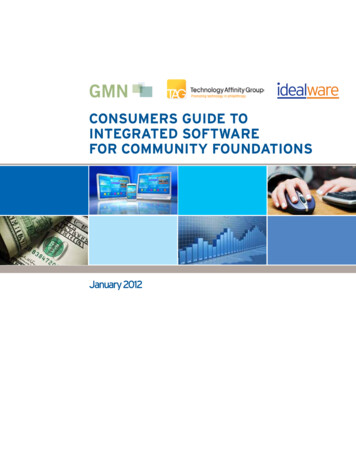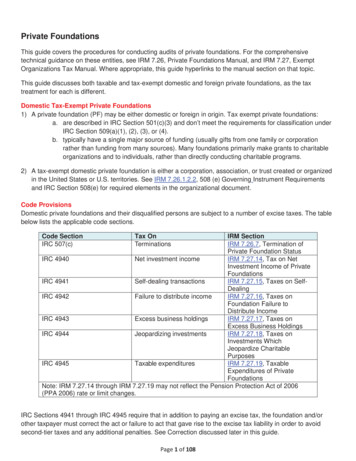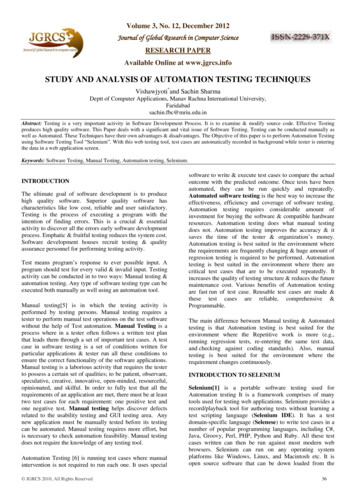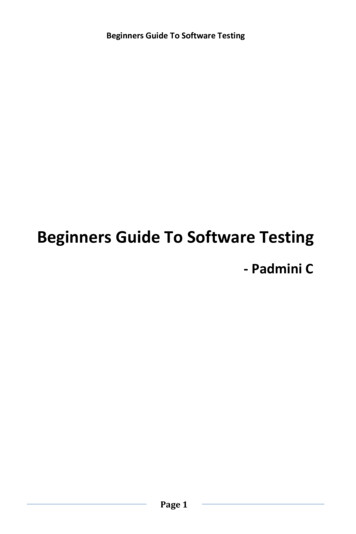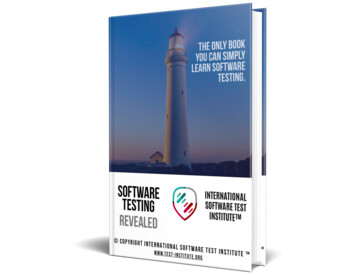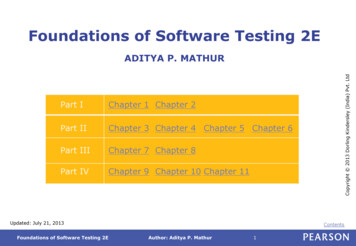
Transcription
Foundations of Software Testing 2EPart IChapter 1 Chapter 2Part IIChapter 3 Chapter 4 Chapter 5 Chapter 6Part IIIChapter 7 Chapter 8Part IVChapter 9 Chapter 10 Chapter 11Updated: July 21, 2013Foundations of Software Testing 2ECopyright 2013 Dorling Kindersley (India) Pvt. LtdADITYA P. MATHURContentsAuthor: Aditya P. Mathur1
Chapter 1:Updated: July 17, 2013Foundations of Software Testing 2ECopyright 2013 Dorling Kindersley (India) Pvt. LtdPreliminaries: Software TestingContentsAuthor: Aditya P. Mathur2
Learning ObjectivesErrors, Testing, debugging, test process, CFG, correctness, reliability,Copyright 2013 Dorling Kindersley (India) Pvt. Ltdn oracles.n Finite state machinesn Testing techniquesContentsFoundations of Software Testing 2EAuthor: Aditya P. Mathur3
Copyright 2013 Dorling Kindersley (India) Pvt. Ltd1.1 Humans, errors and testingContentsFoundations of Software Testing 2EAuthor: Aditya P. Mathur4
ErrorsErrors are a part of our daily life.Copyright 2013 Dorling Kindersley (India) Pvt. LtdHumans make errors in their thoughts, actions, and in the products thatmight result from theiractions.Errors occur wherever humans are involved in taking actions and makingdecisions.These fundamental facts of human existencemake testing an essential activity.ContentsFoundations of Software Testing 2EAuthor: Aditya P. Mathur5
Copyright 2013 Dorling Kindersley (India) Pvt. LtdErrors: ExamplesContentsFoundations of Software Testing 2EAuthor: Aditya P. Mathur6
Copyright 2013 Dorling Kindersley (India) Pvt. LtdError, faults, failuresContentsFoundations of Software Testing 2EAuthor: Aditya P. Mathur7
Copyright 2013 Dorling Kindersley (India) Pvt. Ltd1.2 Software QualityContentsFoundations of Software Testing 2EAuthor: Aditya P. Mathur8
Copyright 2013 Dorling Kindersley (India) Pvt. LtdSoftware qualityStatic quality attributes: structured, maintainable, testable code as well asthe availability of correct and complete documentation.Dynamic quality attributes: software reliability, correctness,completeness, consistency, usability, and performanceContentsFoundations of Software Testing 2EAuthor: Aditya P. Mathur9
Software quality (contd.)Copyright 2013 Dorling Kindersley (India) Pvt. LtdCompleteness refers to the availability of all features listed in the requirements,or in the user manual. An incomplete software is one that does not fullyimplement all features required.Consistency refers to adherence to a common set of conventions andassumptions. For example, all buttons in the user interface might follow acommon color coding convention. An example of inconsistency would be whena database application displays the date of birth of a person in the database.ContentsFoundations of Software Testing 2EAuthor: Aditya P. Mathur10
Software quality (contd.)Usability refers to the ease with which an application can be used. This is anCopyright 2013 Dorling Kindersley (India) Pvt. Ltdarea in itself and there exist techniques for usability testing. Psychology playsan important role in the design of techniques for usability testing.Performance refers to the time the application takes to perform a requestedtask. It is considered as a non-functional requirement. It is specified in termssuch as This task must be performed at the rate of X units of activity in onesecond on a machine running at speed Y, having Z gigabytes of memory."ContentsFoundations of Software Testing 2EAuthor: Aditya P. Mathur11
ContentsFoundations of Software Testing 2EAuthor: Aditya P. Mathur12Copyright 2013 Dorling Kindersley (India) Pvt. Ltd1.3 Requirements, behavior, and correctness
Copyright 2013 Dorling Kindersley (India) Pvt. LtdRequirements, behavior, correctnessRequirements leading to two different programs:Requirement 1: It is required to write aprogram that inputs two integers and outputs the maximum of these.Requirement 2: It is required to write aprogram that inputs a sequence of integers and outputs the sorted version ofthis sequence.ContentsFoundations of Software Testing 2EAuthor: Aditya P. Mathur13
Requirements: Incompletenessof max when the input integers are 13 and 19 can be easily determined to be 19.Suppose now that the tester wants to know if the two integers are to be input to theprogram on one line followed by a carriage return, or on two separate lines with acarriage return typed in after each number. The requirement as stated above fails toprovide an answer to this question.ContentsFoundations of Software Testing 2EAuthor: Aditya P. Mathur14Copyright 2013 Dorling Kindersley (India) Pvt. LtdSuppose that program max is developed to satisfy Requirement 1. The expected output
Requirement 2 is ambiguous. It is not clear whether the input sequence is to sortedin ascending or in descending order. The behavior of sort program, written to satisfythis requirement, will depend on the decision taken by the programmer while writingsort.ContentsFoundations of Software Testing 2EAuthor: Aditya P. Mathur15Copyright 2013 Dorling Kindersley (India) Pvt. LtdRequirements: Ambiguity
The set of all possible inputs to a program P is known as the input domain or inputspace, of P.Using Requirement 1 above we find the input domain of maxto be the set of all pairs of integers where each element in the pair integers is in therange -32,768 till 32,767.Using Requirement 2 it is not possible to find the input domain for the sortprogram.ContentsFoundations of Software Testing 2EAuthor: Aditya P. Mathur16Copyright 2013 Dorling Kindersley (India) Pvt. LtdInput domain (Input space)
Input domain (Continued)Modified Requirement 2:Copyright 2013 Dorling Kindersley (India) Pvt. LtdIt is required to write a program that inputs asequence of integers and outputs the integers in this sequence sorted in eitherascending or descending order. The order of the output sequence is determined byan input request character which should be A'' when an ascending sequence isdesired, and D'' otherwise.While providing input to the program, the request character is input first followedby the sequence of integers to be sorted; the sequence is terminated with a period.ContentsFoundations of Software Testing 2EAuthor: Aditya P. Mathur17
Based on the above modified requirement, the input domain for sort is a set ofpairs. The first element of the pair is a character. The second element of the pairis a sequence of zero or more integers ending with a period.ContentsFoundations of Software Testing 2EAuthor: Aditya P. Mathur18Copyright 2013 Dorling Kindersley (India) Pvt. LtdInput domain (Continued)
Valid/Invalid InputsThe modified requirement for sort mentions that theCopyright 2013 Dorling Kindersley (India) Pvt. Ltdrequest characters can be A'' and D'', but fails to answer the question Whatif the user types a different character ?’’When using sort it is certainly possible for the user to type acharacter other than A'' and D''. Any character other than A'’ and D'' isconsidered as invalid input to sort. The requirement for sort does not specifywhat action it should take when an invalid input is encountered.ContentsFoundations of Software Testing 2EAuthor: Aditya P. Mathur19
Copyright 2013 Dorling Kindersley (India) Pvt. Ltd1.4 Correctness versus reliabilityContentsFoundations of Software Testing 2EAuthor: Aditya P. Mathur20
Correctnessnever the objective of testing.To establish correctness via testing would imply testing a program on allelements in the input domain. In most cases that are encountered in practice, thisis impossible to accomplish.Thus, correctness is established viamathematical proofs of programs.ContentsFoundations of Software Testing 2EAuthor: Aditya P. Mathur21Copyright 2013 Dorling Kindersley (India) Pvt. LtdThough correctness of a program is desirable, it is almost
Correctness and TestingCopyright 2013 Dorling Kindersley (India) Pvt. LtdWhile correctness attempts to establish that the program is error free, testingattempts to find if there are any errors in it.Thus, completeness of testing does not necessarily demonstrate that a program iserror free.Testing, debugging, and the error removal processes together increase ourconfidence in the correct functioning of the program under test.ContentsFoundations of Software Testing 2EAuthor: Aditya P. Mathur22
Copyright 2013 Dorling Kindersley (India) Pvt. LtdSoftware reliability: two definitionsSoftware reliability [ANSI/IEEE Std 729-1983]: is the probability offailure free operation of software over a given time interval and under givenconditions.Software reliability is the probability of failure free operation of softwarein its intended environment.ContentsFoundations of Software Testing 2EAuthor: Aditya P. Mathur23
Operational profileCopyright 2013 Dorling Kindersley (India) Pvt. LtdAn operational profile is a numerical description of how a program is used.Consider a sort program which, on any given execution, allows any one of twotypes of input sequences. Sample operational profiles for sort follow.ContentsFoundations of Software Testing 2EAuthor: Aditya P. Mathur24
Copyright 2013 Dorling Kindersley (India) Pvt. LtdOperational profileContentsFoundations of Software Testing 2EAuthor: Aditya P. Mathur25
Copyright 2013 Dorling Kindersley (India) Pvt. LtdOperational profileContentsFoundations of Software Testing 2EAuthor: Aditya P. Mathur26
Copyright 2013 Dorling Kindersley (India) Pvt. Ltd1.5 Testing and debuggingContentsFoundations of Software Testing 2EAuthor: Aditya P. Mathur27
Testing is the process of determining if a program has any errors.When testing reveals an error, the process used to determine the cause of this errorand to remove it, is known as debugging.ContentsFoundations of Software Testing 2EAuthor: Aditya P. Mathur28Copyright 2013 Dorling Kindersley (India) Pvt. LtdTesting and debugging
Copyright 2013 Dorling Kindersley (India) Pvt. LtdA test/debug cycleContentsFoundations of Software Testing 2EAuthor: Aditya P. Mathur29
Test planExample: The sort program is to be tested to meet the requirements given earlier.Specifically, the following needs to be done. Execute sort on at least two input sequences, one with A'' andthe other with D'' as request characters.ContentsFoundations of Software Testing 2EAuthor: Aditya P. Mathur30Copyright 2013 Dorling Kindersley (India) Pvt. LtdA test cycle is often guided by a test plan.
Execute the program on an empty input sequence. Test the program for robustness against erroneous inputs such as R''Copyright 2013 Dorling Kindersley (India) Pvt. LtdTest plan (contd.)typed in as the request character. All failures of the test program should be recorded in a suitable file usingthe Company Failure Report Form.ContentsFoundations of Software Testing 2EAuthor: Aditya P. Mathur31
Test case/dataA test case is a pair consisting of test data to be input to the program and theCopyright 2013 Dorling Kindersley (India) Pvt. Ltdexpected output. The test data is a set of values, one for each input variable.A test set is a collection of zero or more test cases.Sample test case for sort:Test data: ''A'’ 12 -29 32 Expected output: -29 12 32ContentsFoundations of Software Testing 2EAuthor: Aditya P. Mathur32
Copyright 2013 Dorling Kindersley (India) Pvt. LtdProgram behaviorCan be specified in several ways: plain natural language, a state diagram,formal mathematical specification, etc.A state diagram specifies program states and how the program changes itsstate on an input sequence. inputs.ContentsFoundations of Software Testing 2EAuthor: Aditya P. Mathur33
Program behavior: ExampleCopyright 2013 Dorling Kindersley (India) Pvt. LtdConsider a menudriven application.ContentsFoundations of Software Testing 2EAuthor: Aditya P. Mathur34
Copyright 2013 Dorling Kindersley (India) Pvt. LtdProgram behavior: Example (contd.)ContentsFoundations of Software Testing 2EAuthor: Aditya P. Mathur35
Behavior: observation and analysisCopyright 2013 Dorling Kindersley (India) Pvt. LtdIn the first step one observes the behavior.In the second step one analyzes the observed behavior to check if it is corrector not. Both these steps could be quite complex for large commercialprograms.The entity that performs the task of checking the correctness of theobserved behavior is known as an oracle.ContentsFoundations of Software Testing 2EAuthor: Aditya P. Mathur36
Copyright 2013 Dorling Kindersley (India) Pvt. LtdOracle: ExampleContentsFoundations of Software Testing 2EAuthor: Aditya P. Mathur37
Oracle: ProgramsCopyright 2013 Dorling Kindersley (India) Pvt. LtdOracles can also be programs designed to check the behavior of otherprograms.For example, one might use a matrix multiplication programto check if a matrix inversion program has produced the correctoutput. In this case, the matrix inversion program inverts a givenmatrix A and generates B as the output matrix.ContentsFoundations of Software Testing 2EAuthor: Aditya P. Mathur38
Copyright 2013 Dorling Kindersley (India) Pvt. LtdOracle: ConstructionConstruction of automated oracles, such as the one to check a matrixmultiplication program or a sort program, requires the determination of inputoutput relationship.In general, the construction of automated oracles is a complexundertaking.ContentsFoundations of Software Testing 2EAuthor: Aditya P. Mathur39
Copyright 2013 Dorling Kindersley (India) Pvt. LtdOracle construction: ExampleContentsFoundations of Software Testing 2EAuthor: Aditya P. Mathur40
Program verification aims at proving the correctness of programs by showingthat it contains no errors. This is very different from testing that aims atuncovering errors in a program.Program verification and testing are best considered as complementary techniques.In practice, program verification is often avoided, and the focus is on testing.ContentsFoundations of Software Testing 2EAuthor: Aditya P. Mathur41Copyright 2013 Dorling Kindersley (India) Pvt. LtdTesting and verification
Testing and verification (contd.)despite the success of a set of tests.Verification promises to verify that a program is free from errors. However, theperson/tool who verified a program might have made a mistake in the verificationprocess; there might be an incorrect assumption on the input conditions; incorrectassumptions might be made regarding the components that interface with theprogram, and so on.Verified and published programs have been shown to beincorrect.ContentsFoundations of Software Testing 2EAuthor: Aditya P. Mathur42Copyright 2013 Dorling Kindersley (India) Pvt. LtdTesting is not a perfect technique in that a program might contain errors
Copyright 2013 Dorling Kindersley (India) Pvt. Ltd1.10. Test generation strategiesContentsFoundations of Software Testing 2EAuthor: Aditya P. Mathur43
Test generationCopyright 2013 Dorling Kindersley (India) Pvt. LtdAny form of test generation uses a source document. In the most informal oftest methods, the source document resides in the mind of the tester whogenerates tests based on a knowledge of the requirements.In several commercial environments, the process is a bit more formal. The tests aregenerated using a mix of formal and informal methods either directly from therequirements document serving as the source. In more advanced test processes,requirements serve as a source for the development of formal models.ContentsFoundations of Software Testing 2EAuthor: Aditya P. Mathur44
Test generation strategiesCopyright 2013 Dorling Kindersley (India) Pvt. LtdModel based: require that a subset of the requirements be modeled using aformal notation (usually graphical). Models: Finite State Machines, Timedautomata, Petri net, etc.Specification based: require that a subset of the requirements be modeled usinga formal mathematical notation. Examples: B, Z, and Larch.Code based: generate tests directly from the code.ContentsFoundations of Software Testing 2EAuthor: Aditya P. Mathur45
Copyright 2013 Dorling Kindersley (India) Pvt. LtdTest generation strategies (Summary)ContentsFoundations of Software Testing 2EAuthor: Aditya P. Mathur46
Copyright 2013 Dorling Kindersley (India) Pvt. Ltd1.13 Types of software testingContentsFoundations of Software Testing 2EAuthor: Aditya P. Mathur47
Types of testingCopyright 2013 Dorling Kindersley (India) Pvt. LtdOne possible classification is based on the following four classifiers:C1: Source of test generation.C2: Lifecycle phase in which testing takes placeC3: Goal of a specific testing activityC4: Characteristics of the artifact under testContentsFoundations of Software Testing 2EAuthor: Aditya P. Mathur48
Copyright 2013 Dorling Kindersley (India) Pvt. LtdC1: Source of test generationContentsFoundations of Software Testing 2EAuthor: Aditya P. Mathur49
Copyright 2013 Dorling Kindersley (India) Pvt. LtdC2: Lifecycle phaseContentsFoundations of Software Testing 2EAuthor: Aditya P. Mathur50
Copyright 2013 Dorling Kindersley (India) Pvt. LtdC3: Goal of specific testing activityContentsFoundations of Software Testing 2EAuthor: Aditya P. Mathur51
Copyright 2013 Dorling Kindersley (India) Pvt. LtdC4: Artifact under testContentsFoundations of Software Testing 2EAuthor: Aditya P. Mathur52
Copyright 2013 Dorling Kindersley (India) Pvt. LtdSummaryWe have dealt with some of the most basic concepts in softwaretesting. Exercises at the end of Chapter 1 are to help you sharpenyour understanding.ContentsFoundations of Software Testing 2EAuthor: Aditya P. Mathur53
Copyright 2013 Dorling Kindersley (India) Pvt. LtdChapter 2:Preliminaries: MathematicalUpdated: July 12, 2013Foundations of Software Testing 2EContentsAuthor: Aditya P. Mathur54
Copyright 2013 Dorling Kindersley (India) Pvt. Ltd2.1 Predicates and Boolean expressionsContentsFoundations of Software Testing 2EAuthor: Aditya P. Mathur55
Copyright 2013 Dorling Kindersley (India) Pvt. LtdWhere do predicates arise?Predicates arise from requirements in a variety of applications. Here is an examplefrom Paradkar, Tai, and Vouk, “Specification based testing using cause-effectgraphs, Annals of Software Engineering,” V 4, pp 133-157, 1997.A boiler needs to be to be shut down when the following conditions hold:ContentsFoundations of Software Testing 2EAuthor: Aditya P. Mathur56
1.The water level in the boiler is below X lbs. (a)2.The water level in the boiler is above Y lbs. (b)3.A water pump has failed. (c)4.A pump monitor has failed. (d)5.Steam meter has failed. (e)Boiler in degraded mode wheneither is true.The boiler is to be shut down when a or b is true or the boiler is in degraded modeand the steam meter fails. We combine these five conditions to form a compoundcondition (predicate) for boiler shutdown.ContentsFoundations of Software Testing 2EAuthor: Aditya P. Mathur57Copyright 2013 Dorling Kindersley (India) Pvt. LtdBoiler shutdown conditions
Boiler shutdown conditionsCopyright 2013 Dorling Kindersley (India) Pvt. LtdDenoting the five conditions above as a through e, we obtain the following Booleanexpression E that when true must force a boiler shutdown:E a b (c d)ewhere the sign indicates “OR” and a multiplication indicates “AND.”The goal of predicate-based test generation is to generate tests from a predicate pthat guarantee the detection of any error that belongs to a class of errors in thecoding of p.ContentsFoundations of Software Testing 2EAuthor: Aditya P. Mathur58
Another exampleFor example, consider the requirement if the printer is ON and has paper then send document to printer.”This statement consists of a condition part and an action part. The following predicaterepresents the condition part of the statement.pr: (printer status ON) (printer tray! empty)ContentsFoundations of Software Testing 2EAuthor: Aditya P. Mathur59Copyright 2013 Dorling Kindersley (India) Pvt. LtdA condition is represented formally as a predicate, also known as a Boolean expression.
We will now examine two techniques, named BOR and BRO for generating teststhat are guaranteed to detect certain faults in the coding of conditions. Theconditions from which tests are generated might arise from requirements or might beembedded in the program to be tested.Conditions guard actions. For example,if condition then actionis a typical format of many functional requirements.ContentsFoundations of Software Testing 2EAuthor: Aditya P. Mathur60Copyright 2013 Dorling Kindersley (India) Pvt. LtdTest generation from predicates
PredicatesRelational operators (relop):{ , , , , , .}Copyright 2013 Dorling Kindersley (India) Pvt. Ltd and are equivalent.Boolean operators (bop): {!, , , xor} also known as{not, AND, OR, XOR}.Relational expression: e1 relop e2. (e.g. a b c)e1 and e2 are expressions whose values can be compared using relop.Simple predicate:A Boolean variable or a relationalexpression. (x 0)Compound predicate: Join one or more simple predicatesusing bop. (gender “female” age 65)ContentsFoundations of Software Testing 2EAuthor: Aditya P. Mathur61
Boolean expression: one or more Boolean variables joined by bop.(a b !c)a, b, and c are also known as literals. Negation is also denoted by placing a bar overa Boolean expression such as in(a b)We also write ab for a b and a b for a b when there is no confusion.Singular Boolean expression: When each literal appearsonly once, e.g., in (a b !c)ContentsFoundations of Software Testing 2EAuthor: Aditya P. Mathur62Copyright 2013 Dorling Kindersley (India) Pvt. LtdBoolean expressions
Boolean expressions (contd.)Copyright 2013 Dorling Kindersley (India) Pvt. LtdDisjunctive normal form (DNF): Sum of product terms:e.g. (p q) (rs) (a c).Conjunctive normal form (CNF): Product of sums:e.g.: (p q)(r s)(a c)Any Boolean expression in DNF can be converted to an equivalent CNF and viceversa.e.g., CNF: (p !r)(p s)(q !r)(q s) is equivalent to DNF: (pq !rs)ContentsFoundations of Software Testing 2EAuthor: Aditya P. Mathur63
Mutually singular: Boolean expressions e1 and e2 are mutually singular when theydo not share any literal.If expression E contains components e1, e2,. then ei is considered singular only if itis non-singular and mutually singular with the remaining elements of E.ContentsFoundations of Software Testing 2EAuthor: Aditya P. Mathur64Copyright 2013 Dorling Kindersley (India) Pvt. LtdBoolean expressions (contd.)
Abstract syntax tree (AST) for: (a b) c !p.Copyright 2013 Dorling Kindersley (India) Pvt. LtdBoolean expressions: Syntax treerepresentationRoot node (AND-node)Notice that internal nodes are labeled by Boolean and relational operatorsRoot node: OR-node is labeledas . (a b)!cpLeaf nodesContentsFoundations of Software Testing 2EAuthor: Aditya P. Mathur65
Copyright 2013 Dorling Kindersley (India) Pvt. Ltd2.2 Program representation: Control flow graphsContentsFoundations of Software Testing 2EAuthor: Aditya P. Mathur66
A basic block in program P is a sequence of consecutive statements with asingle entry and a single exit point. Thus, a block has unique entry and exitpoints.Control always enters a basic block at its entry point and exits from its exit point.There is no possibility of exit or a halt at any point inside the basic block except atits exit point. The entry and exit points of a basic block coincide when the blockcontains only one statement.ContentsFoundations of Software Testing 2EAuthor: Aditya P. Mathur67Copyright 2013 Dorling Kindersley (India) Pvt. LtdProgram representation: Basic blocks
Basic blocks: ExampleCopyright 2013 Dorling Kindersley (India) Pvt. LtdExample: Computing x raised to yContentsFoundations of Software Testing 2EAuthor: Aditya P. Mathur68
Basic blocks: Example (contd.)Copyright 2013 Dorling Kindersley (India) Pvt. LtdBasic blocksContentsFoundations of Software Testing 2EAuthor: Aditya P. Mathur69
A control flow graph (or flow graph) G is defined as a finite set N of nodes and a finiteset E of edges. An edge (i, j) in E connects two nodes ni and nj in N. We often write G (N, E) to denote a flow graph G with nodes given by N and edges by E.ContentsFoundations of Software Testing 2EAuthor: Aditya P. Mathur70Copyright 2013 Dorling Kindersley (India) Pvt. LtdControl Flow Graph (CFG)
Control Flow Graph (CFG)indicate the flow of control between blocks.Blocks and nodes are labeled such that block bi corresponds to node ni. An edge (i,j) connecting basic blocks bi and bj implies that control can go from block bi toblock bj.We also assume that there is a node labeled Start in N that has no incoming edge, andanother node labeled End, also in N, that has no outgoing edge.ContentsFoundations of Software Testing 2EAuthor: Aditya P. Mathur71Copyright 2013 Dorling Kindersley (India) Pvt. LtdIn a flow graph of a program, each basic block becomes a node and edges are used to
Copyright 2013 Dorling Kindersley (India) Pvt. LtdCFG ExampleN {Start, 1, 2, 3, 4, 5, 6, 7, 8, 9, End}E {(Start,1), (1, 2), (1, 3), (2,4), (3, 4), (4, 5), (5,6), (6, 5), (5, 7), (7, 8), (7, 9), (9, End)}ContentsFoundations of Software Testing 2EAuthor: Aditya P. Mathur72
CFG ExampleCopyright 2013 Dorling Kindersley (India) Pvt. LtdSame CFG with statements removed.N {Start, 1, 2, 3, 4, 5, 6, 7, 8, 9, End}E {(Start,1), (1, 2), (1, 3), (2,4), (3, 4), (4, 5),(5, 6), (6, 5), (5, 7), (7, 8), (7, 9), (9, End)}ContentsFoundations of Software Testing 2EAuthor: Aditya P. Mathur73
PathsCopyright 2013 Dorling Kindersley (India) Pvt. LtdConsider a flow graph G (N, E). A sequence of k edges, k 0, (e 1, e 2, e k) ,denotes a path of length k through the flow graph if the following sequencecondition holds.Given that np, nq, nr, and ns are nodes belonging to N, and 0 i k, if ei (np, nq) and ei 1 (nr, ns) then nq nr. }ContentsFoundations of Software Testing 2EAuthor: Aditya P. Mathur74
Paths: sample paths through the exponentiationflow graphCopyright 2013 Dorling Kindersley (India) Pvt. LtdTwo feasible and complete paths:p1 ( Start, 1, 2, 4, 5, 6, 5, 7, 9, End)p2 (Start, 1, 3, 4, 5, 6, 5, 7, 9, End)Specified unambiguously using edges:p1 ( (Start, 1), (1, 2), (2, 4), (4, 5), (5, 6), (6,5), (5, 7), (7, 9), (9, End))Bold edges: complete path.Dashed edges: subpath.ContentsFoundations of Software Testing 2EAuthor: Aditya P. Mathur75
Paths: infeasibleCopyright 2013 Dorling Kindersley (India) Pvt. LtdA path p through a flow graph for program P isconsidered feasible if there exists at least one testcase which when input to P causes p to betraversed.p1 ( Start, 1, 3, 4, 5, 6, 5, 7, 8, 9, End)p2 (Start, 1, 1, 2, 4, 5, 7, 9, , End)ContentsFoundations of Software Testing 2EAuthor: Aditya P. Mathur76
Number of pathscondition contains exactly one path that begins at node Start and terminates atnode End.Each additional condition in the program can increases the number of distinct pathsby at least one.Depending on their location, conditions can have a multiplicative effecton the number of paths.ContentsFoundations of Software Testing 2EAuthor: Aditya P. Mathur77Copyright 2013 Dorling Kindersley (India) Pvt. LtdThere can be many distinct paths through a program. A program with no
Copyright 2013 Dorling Kindersley (India) Pvt. Ltd2.6 Strings, languages, and regular expressionsContentsFoundations of Software Testing 2EAuthor: Aditya P. Mathur78
Strings play an important role in testing. A string serves as a test input.Examples: 1011; AaBc; “Hello world”.A collection of strings also forms a language. For example, a set of all stringsconsisting of zeros and ones is the language of binary numbers. In this section weprovide a brief introduction to strings and languages.ContentsFoundations of Software Testing 2EAuthor: Aditya P. Mathur79Copyright 2013 Dorling Kindersley (India) Pvt. LtdStrings
AlphabetCopyright 2013 Dorling Kindersley (India) Pvt. LtdA collection of symbols is known as an alphabet. We use an upper case lettersuch as X and Y to denote alphabets.Though alphabets can be infinite, we are concerned only with finite alphabets. Forexample, X {0, 1} is an alphabet consisting of two symbols 0 and 1. Anotheralphabet is Y {dog, cat, horse, lion}that consists of four symbols dog", cat", horse", and lion".ContentsFoundations of Software Testing 2EAuthor: Aditya P. Mathur80
Strings over an AlphabetCopyright 2013 Dorling Kindersley (India) Pvt. LtdA string over an alphabet X is any sequence of zero or more symbols that belong toX. For example, 0110 is a string over the alphabet {0, 1}. Also, dog cat dog dog lionis a string over the alphabet {dog, cat, horse, lion}.We will use lower case letters such as p, q, r to denote strings. The length of a stringis the number of symbols in that string. Given a string s, we denote its length by s .Thus, 1011 4 and dog cat dog 3. A string of length 0, also known as an emptystring, is denoted by ε.Note that ε denotes an empty string and also stands for “element of”when used with sets.Foundations of Software Testing 2EContentsAuthor: Aditya P. Mathur81
Let s1 and s2 be two strings over alphabet X. We write s1.s2 to denote theconcatenation of strings s1 and s2.For example, given the alphabet X {0, 1}, and two strings 011 and 101 over X, weobtain 011.101 011101. It is easy to see that s1.s2 s1 s2 . Also, for any string s, wehave s. ε s and ε.s s.ContentsFoundations of Software Testing 2EAuthor: Aditya P. Mathur82Copyright 2013 Dorling Kindersley (India) Pvt. LtdString concatenation
LanguagesCopyright 2013 Dorling Kindersley (India) Pvt. LtdA set L of strings over an alphabet X is known as a language. A language can befinite or infinite.The following sets are finite languages over the binary alphabet
Jul 21, 2013 · Foundations of Software Testing 2E Author: Aditya P. Mathur td 11 Contents Software quality (contd.) Usability refers to the ease with which an application can be used. This is an area in itself and there exist techniques for usability testing. Psychology plays an important role in the des



